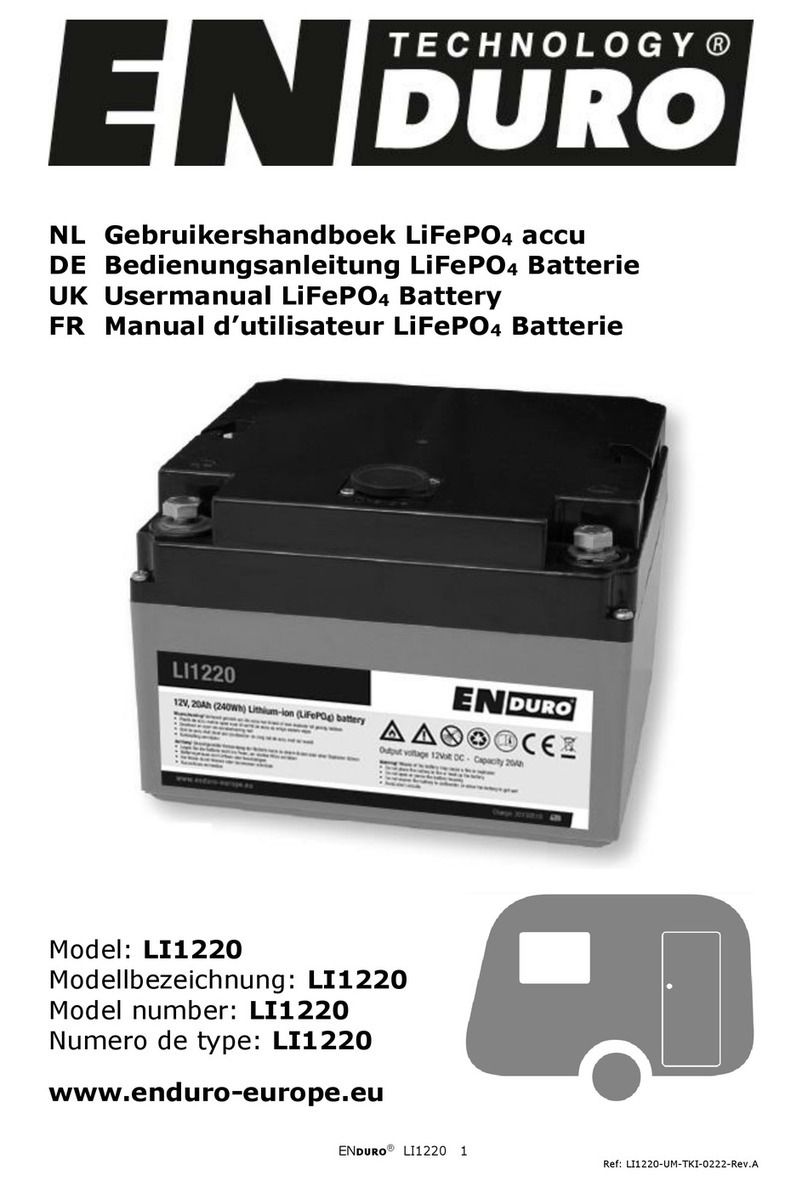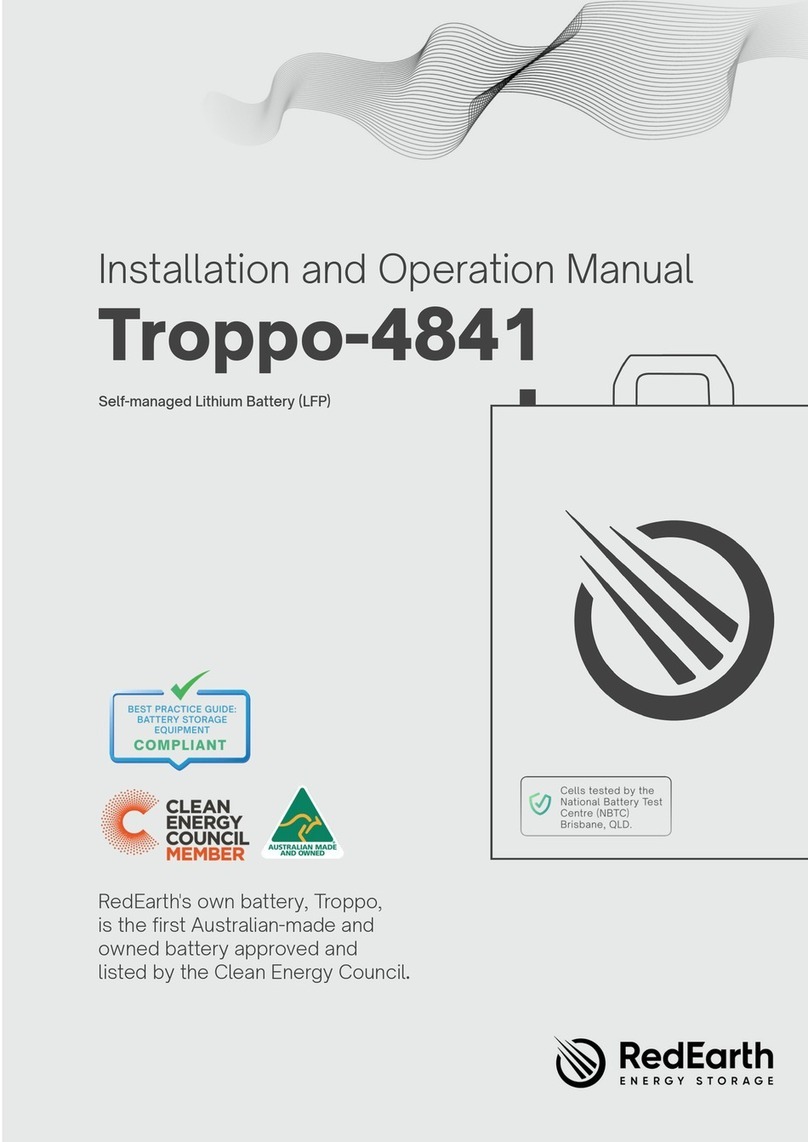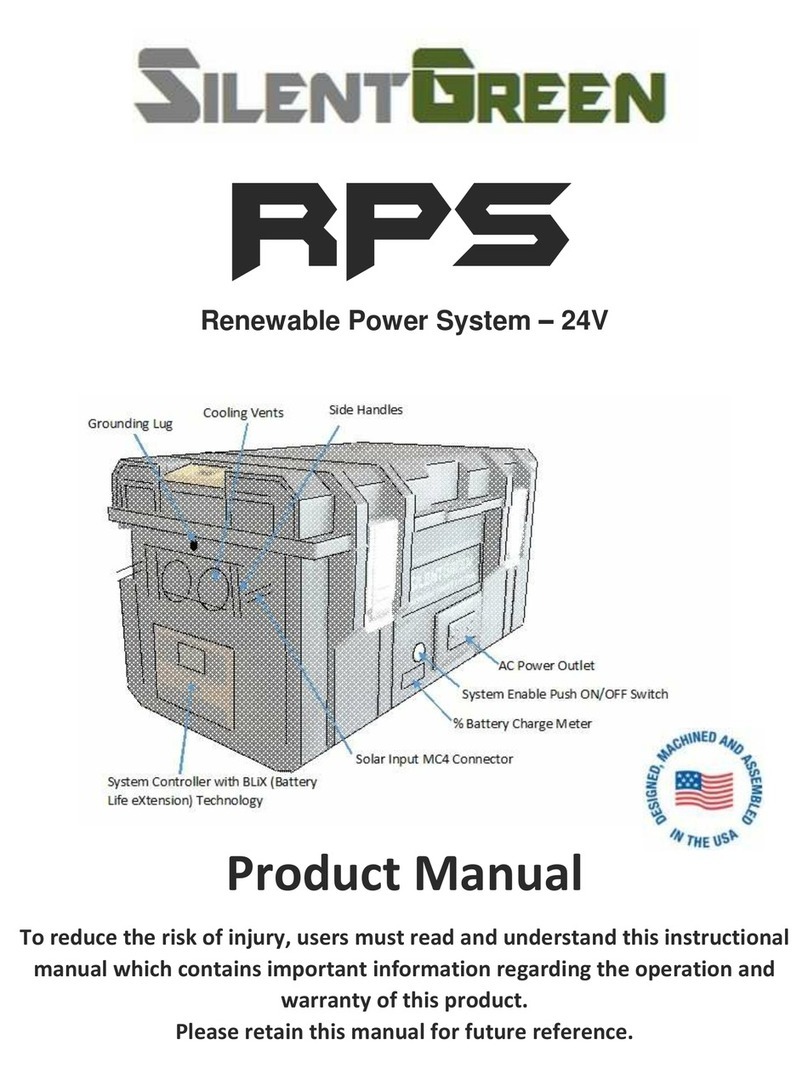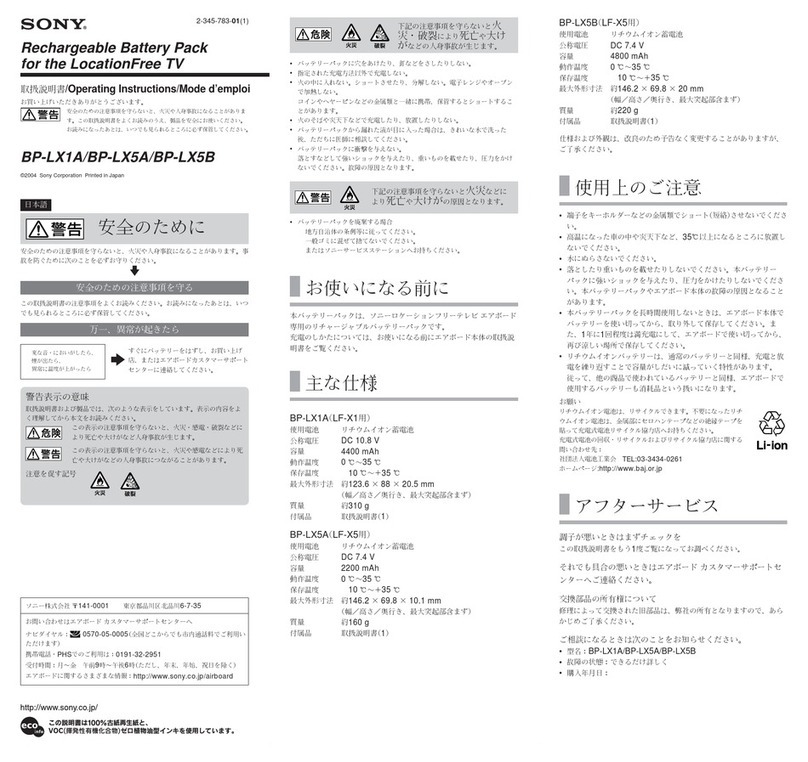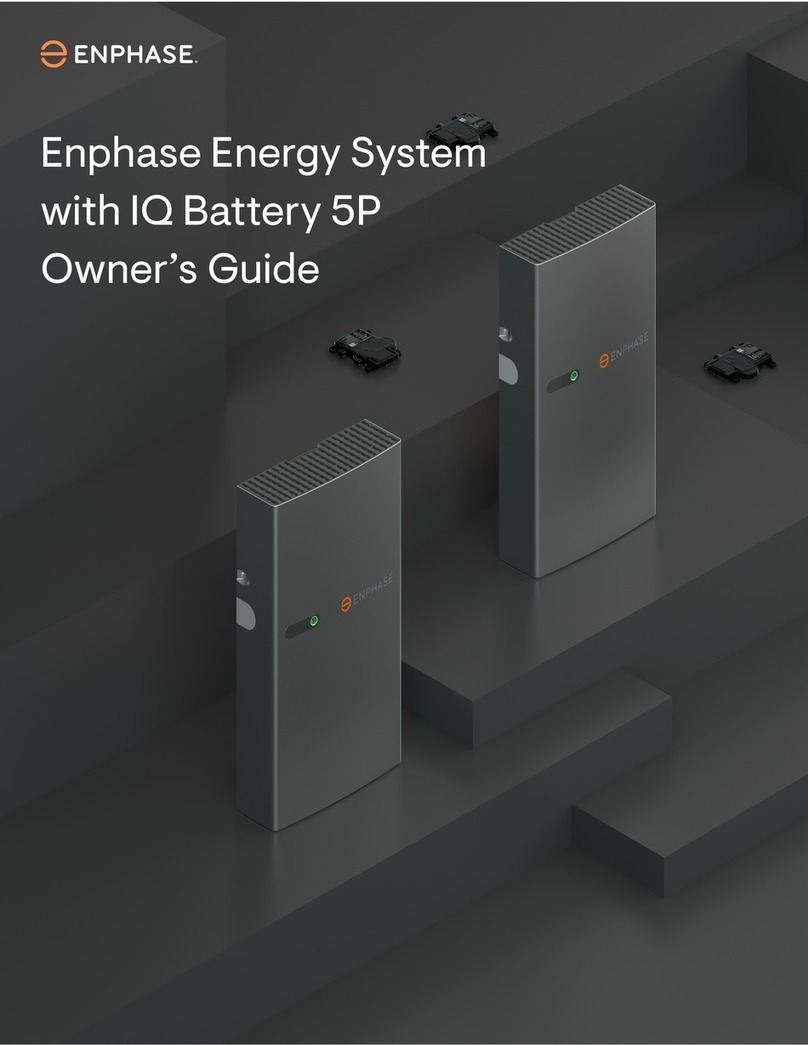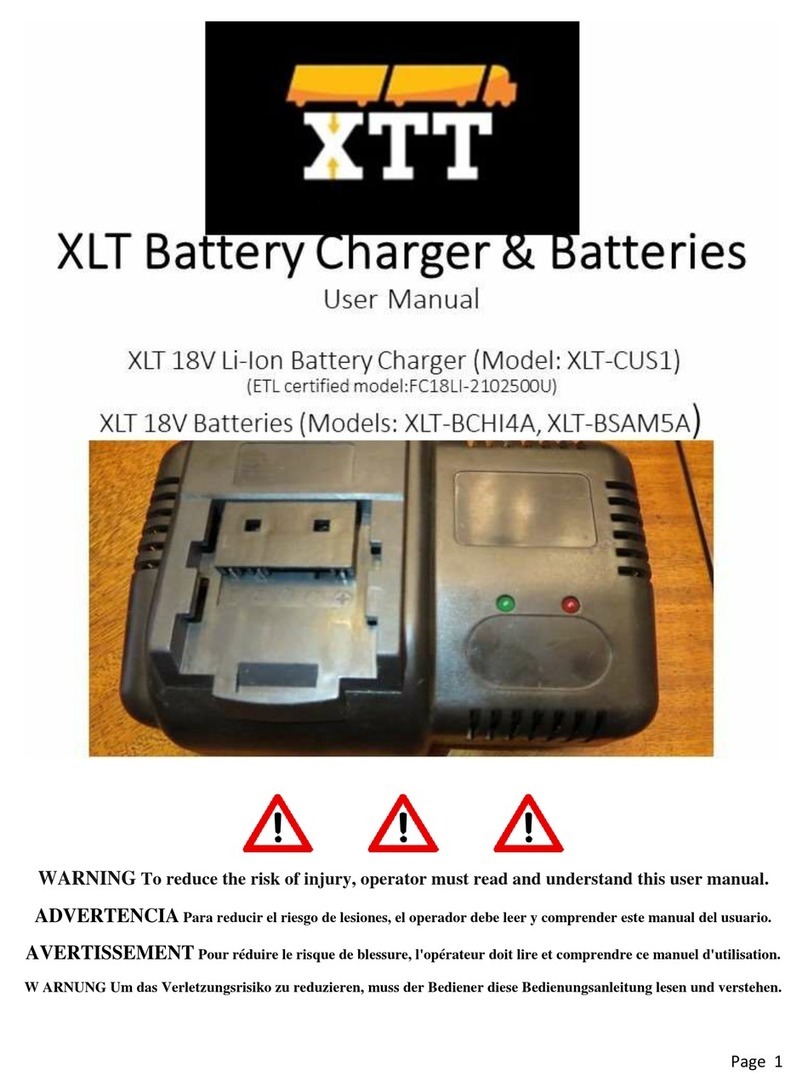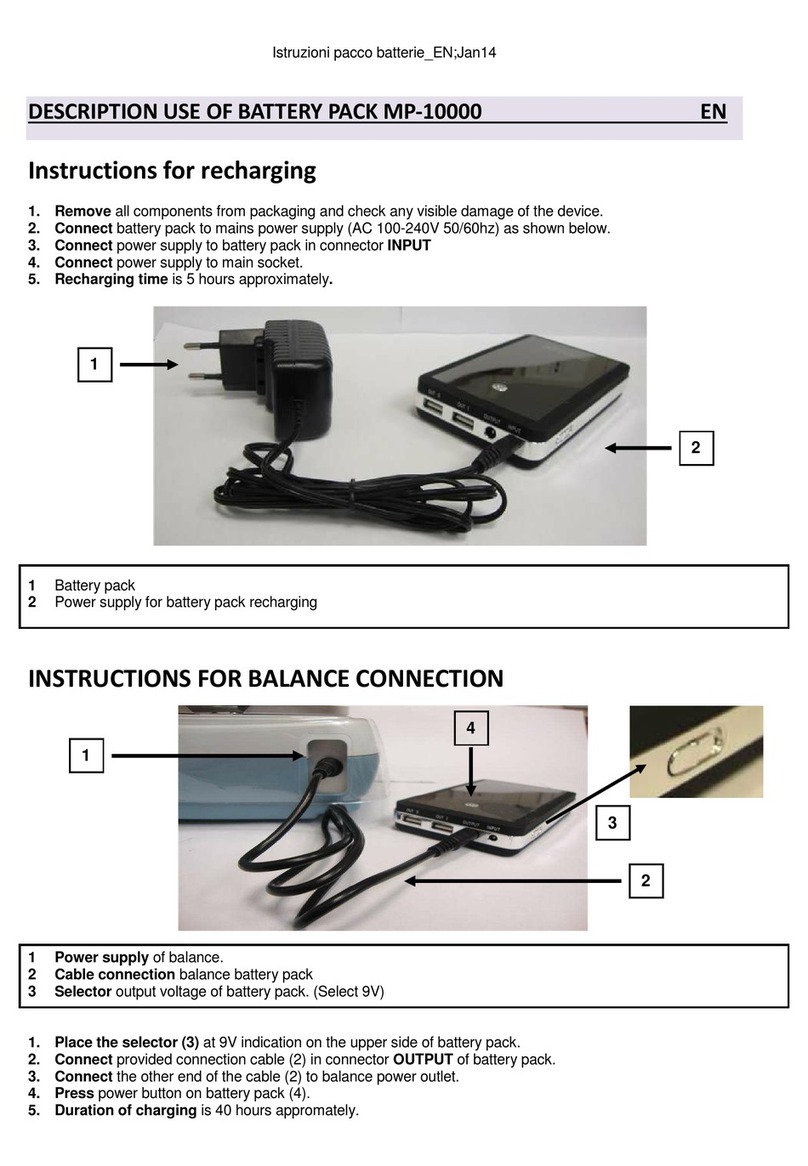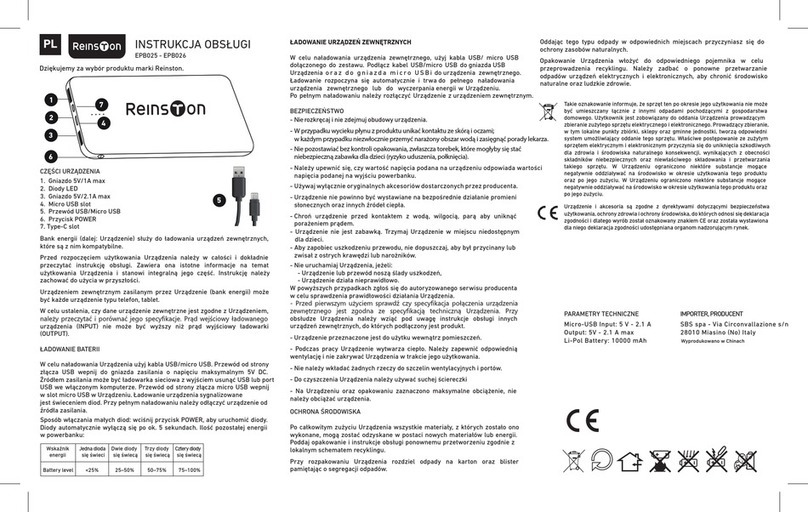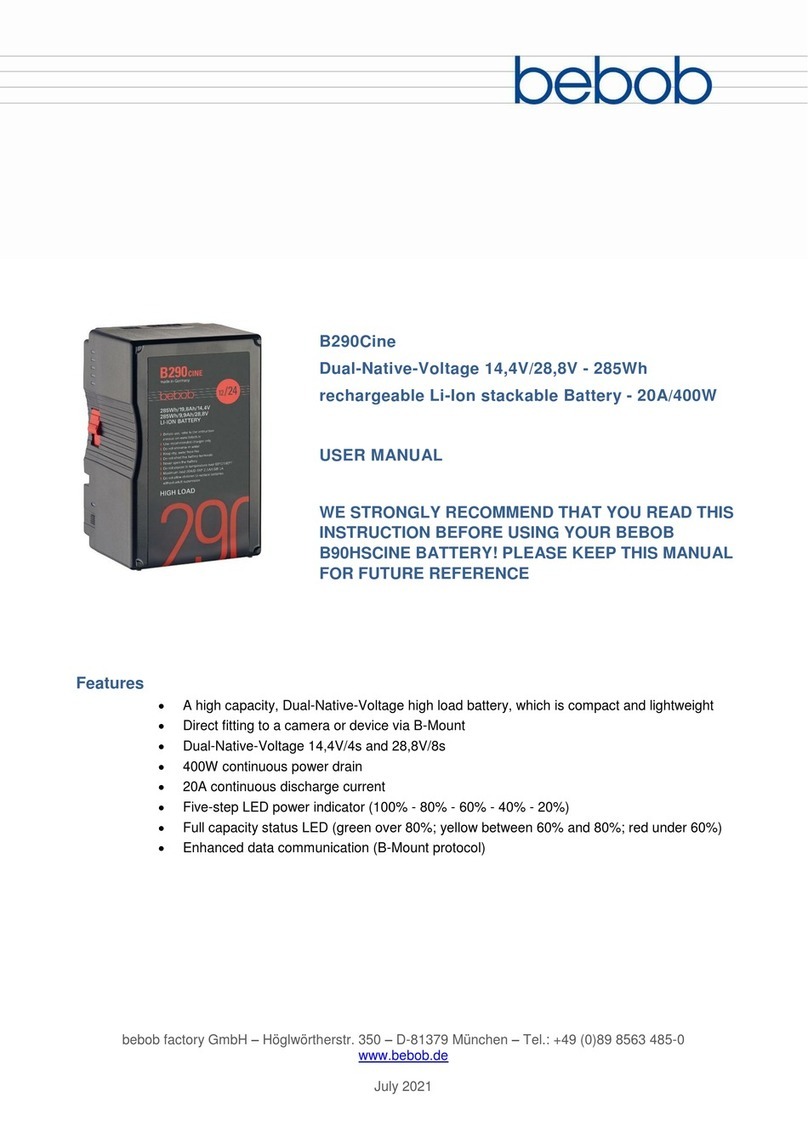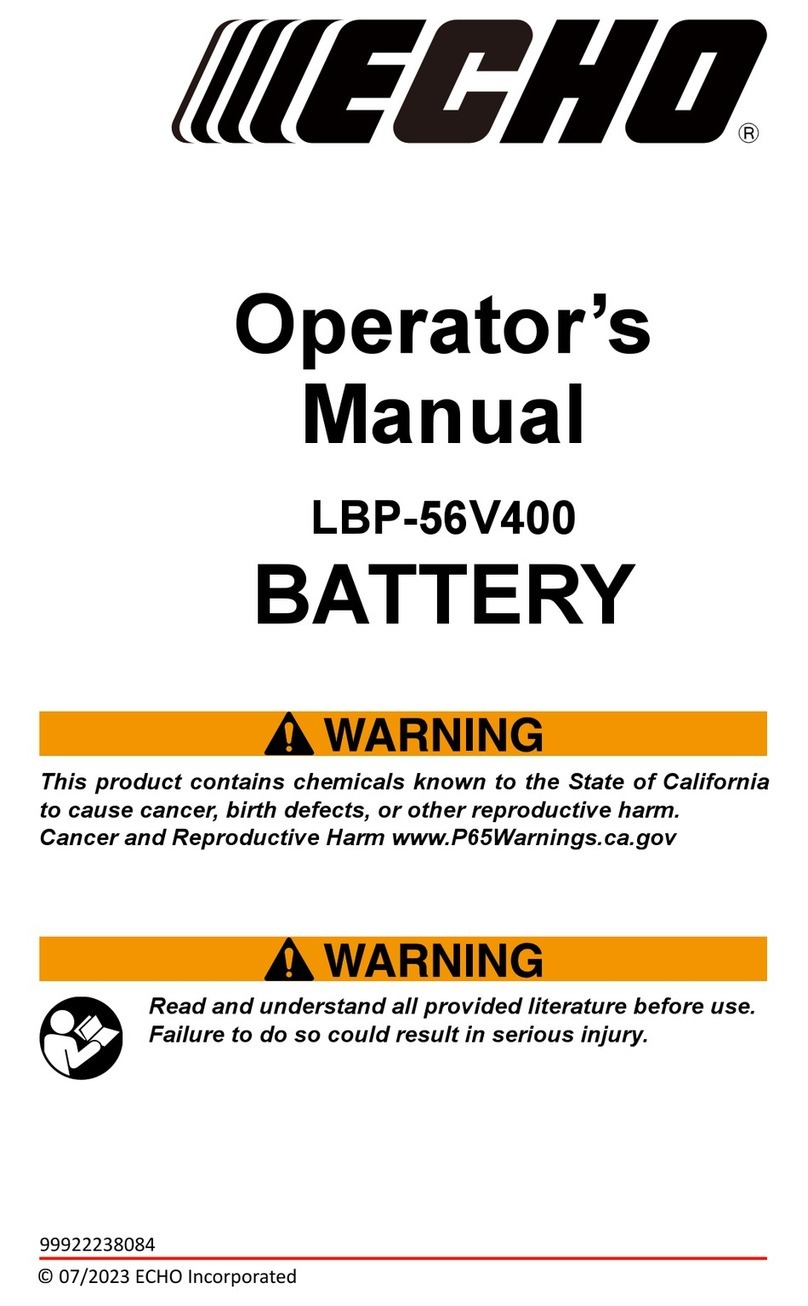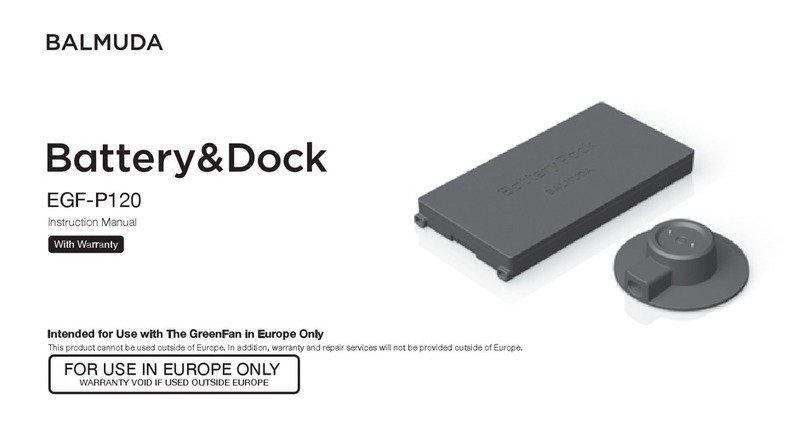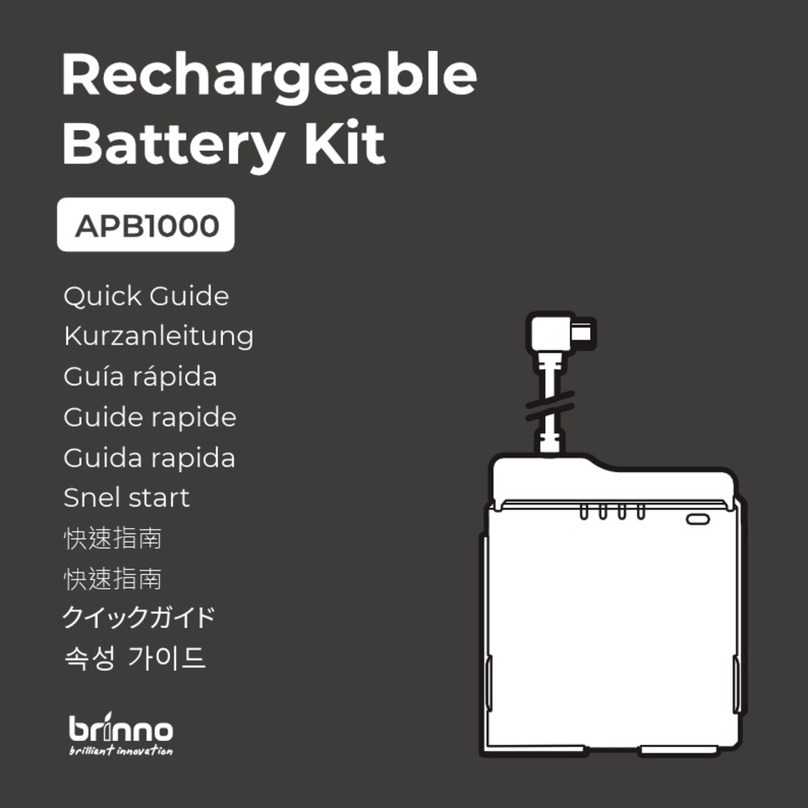Feider Machines FBA20U2 User manual

EN
1
INSTRUCTION MANUAL
20V 2A(4A) LITHIUM ION BATTERY
Model: FBA20U2 / FBA20U4
Original instructions
FEIDER
32, rue Aristide Bergès- ZI31270 Cugnaux-France
Warning: Please read the manual carefully before using the battery!

EN
2
1. SAFETY INFORMATION
WARNING! Read all safety warnings and all instructions. Failure to follow the warnings and instructions may
result in electric shock, fire and/or serious injury. Save all warnings and instructions for future reference.
a) Recharge only with the charger specified by the manufacturer. A charger that is suitable for one type of battery
pack may create a risk of fire when used with another battery pack.
b) Use power tools only with specifically designated battery packs. Use of any other battery packs may create a
risk of injury and fire.
c) When battery pack is not in use, keep it away from other metal objects, like paper clips, coins, keys, nails,
screws or other small metal objects that can make a connection from one terminal to another. Shorting the
battery terminals together may cause burns or a fire.
d) Under abusive conditions, liquid may be ejected from the battery; avoid contact.If contact accidentally
occurs, flush with water. If liquid contacts eyes, additionally seek medical help. Liquid
ejected from the battery may cause irritation or burns.
SPECIFIC SAFETY INSTRUCTIONS
The product is not intended for use by persons (including
children) with reduced physical, sensory or mental
capabilities, or lack of experience and knowledge, unless they
have been given supervision or instruction concerning use of
the product by a person responsible for their safety. Children
should be supervised to ensure that they do not play with the
product.
Please read and observe these instructions before using the
product.
The battery pack for this tool has been shipped in a low
charge condition. You should charge the battery pack fully
before use.
Do not incinerate the battery pack even if it is seriously
damaged or can no longer hold a charge.
The battery pack can explode in a fire.
Batteries can explode in the presence of a source of ignition,
such as a pilot light. To reduce the risk of serious personal
injury, never use any cordless product in the presence of
open flame. An exploded battery can propel debris and
chemicals. If exposed, flush with water immediately.
Do not crush, drop or damage battery pack. Do not use a
battery pack or charger that has been dropped or received a
sharp blow. A damaged battery is subject to explosion.
Properly dispose of a dropped or damaged battery
immediately.
Do not crush, drop or damage battery pack. Do not use a
battery pack or charger that has been dropped or received a
sharp blow. A damaged battery is subject to explosion.
Properly dispose of a dropped or damaged battery
immediately.
A small leakage of liquid from the battery pack may occur
under extreme usage or temperature conditions. This does
not necessarily indicate a failure of the battery pack.
However, if the outer seal is broken and this leakage comes
into contact with your skin wash the affected area quickly
with soap and water. If the leakage gets in your eyes flush
your eyes with clean water for a minimum of 10 minutes and
seek immediate medical attention.
Inform the medical staff that the liquid is a 25-35% solution
of potassium hydroxide.

EN
3
Never attempt to open the battery pack for any reason. If the
plastic housing of the battery pack breaks open or cracks,
immediately discontinue its use and do not recharge it.
Do not store or carry a spare battery pack in a pocket or
toolbox or any other place where it may come into contact
with metal objects. The battery pack may be short- circuited
causing damage to the battery pack, burns or a fire.
Do not charge battery tool in a damp or wet location.
Following this rule will reduce the risk of electric shock.
For best results, change the battery tool in a location where the temperature is more than 10°C but less than 37°C, to reduce
the risk of serious personal injury, do not store outside or in vehicles.
RE-CHARGEABLE BATTERIES
zBatteries may leak or explode if not charged or handled correctly. Always observe the following precautions when
handing batteries.
zEnsure that the machine is switched off before removing or fitting batteries.
zDo not use this battery with any other product.
zDo not attempt to fit the battery the wrong way round.
zDo not short out, or attempt to dismantle the battery.
zDo not expose the battery to flames or excessive heat.
zDo not immerse in or expose the battery to water.
zDo not store or transport the battery with loose metal objects such as drill and drive bits.
zBatteries are points to leakage when discharged. To avoid damage to the product, remove or re-charge the battery
when no charge remains. Store the battery in a cool place when not in use.
zAfter prolonged use the battery may become hot. Before removing the battery, switch the machine off and allow the
battery to cool down. Do not use the battery if you notice any discoloration or distortion of the battery casing.
2. Intended Use
The Li-Ion battery specially design to work with Feider range of cordless power tools as below.
FSC20V165 20V LITHIUM CIRCULAR SAW
FPV20V2B2B 20V LITHIUM DRILL
FMP20V 20V LITHIUM ROTARY HAMMER
FM20V115 20V LITHIUM ANGLE GRINDER
FSS20V 20V LITHIUM JIGSAW
FMT20V 20V LITHIUM MULTI TOOL

EN
4
3. COMPONENTS ( FIG.1)
1 Battery release catch
2 Charge level indictor
3 Charge level indictor botton
EN
17
6. CE DECLARATION
Declaration of conformity
FEIDER
BUILDER SAS
ZI, 32 RUE ARISTIDE BERGES ±312070 CUGNAUX ±FRANCE
Declares that the machinery designated below:
ddZz,Z'Z
Model: FFC20U
Serial number:
Is in conformity with the requirements of the Directive Machine 2006/42/EC and to the followings Europeans
Directives:
EMC Directive 2014/30/EU
ROHS Directive 2011/65/EU
This tool is also in conformity with the following these standards:
EN 60745-1: 2009+A11: 2010
EN 60745-2-3: 2011+A2: 2013+A11: 2014+A12: 2014+A13: 2015
EN 55014-1: 2006+A1: 2009+A2: 2011 EN 55014-2: 2015
Responsible of the technical file: Mr Michel Krebs
Cugnaux, 19/11/2018
Philippe MARIE / PDG

EN
16
Product conforms to RoHs requirements
General warning!
Type of fuse
This product is suitable for indoor use
Waste electrical products should not be disposed of with household
waste. Please recycle where facilities exist. Check with your Local
Authority or retailer for recycling advice.
ϴ/^WK^>
Electric power tools, as well as their accessories and packaging, must each be able to follow an appropriate
recycling pathway. Only for the countries of the European Union:
Do not throw away your electrical appliance with the household waste! In accordance with the European
Directive 2012/19/EU on waste electrical and electronic equipment and its implementation in national laws,
power tools that can no longer be used must be separated and follow an appropriate recycling pathway.
EN
5
4. OPERATION
4.1. Charging the battery pack
Battery pack Charger
FBA20U2 FFC20U
FBA20U4
Warning ! Only charge in compatible 20V chargers. Use of other chargers may result in fire, damage or serious personal
injury.
The battery pack for this tool has been shipped in a low
charge condition to prevent possible problems. Therefore,
you should charge it until the green LED on the front right
hand side of the charger comes on.
Note: Batteries will not reach full charge the first time they
are charged. Allow several cycles (operation followed by
recharging) for them to become fully charged.
First read the safety instructions then follow the charging
instructions.
Plug the charger into a standard 230 V, 50 Hz mains socket
outlet, the green LED on the front left hand side of the
charger will illuminate to indicate.
Do not allow the cable to become knotted or kinked.
Place the battery pack into the charger base.
(Note the battery has raised ribs which allows it to fit into
the charger only one way). Time the charge for 60/130
minutes only.
2.0 Ah-battery, charge for 60 minutes.
4.0 Ah-battery, charge for 130 minutes.
The red LED on the front right hand side of the charger
will illuminate to indicate charging is in progress. A green
LED will illuminate when the battery is fully charged.
Unplug the charger when not in use and store it in a
suitable storage cabinet.
Avoid charging your battery in freezing conditions as charging
power will not be sufficient.
When charging more than one battery pack in succession
allow at least 30 minutes for the charger to cool down
before charging an additional battery.
Always remove the battery pack and store it safely when the
tool is not in use.
Caution: If at any point during the charging process none of
the LEDs are lit, remove the battery pack from the charger
to avoid damaging the product. DO NOT insert another
battery.

EN
6
4.2. CHARGE STATUS (Fig.1)
To display the amount of charge left in the battery, press the charge level indicator button (3),
Charge level indicator Amount of charge remaining
0-10%
10-25%
25-50%
50-75*
75-100%
5. MAINTENANCE AND STORAGE
MAINTENANCE
The batteries have been designed to provide maximum trouble-free life. However, like all batteries, they will eventually wear
out. DO NOT disassemble battery pack and attempt to replace the batteries. Handling of these batteries, especially when
wearing rings and jewellery, could result in serious burns.
To obtain the longest possible battery life, remove the battery pack from the charger once it is fully charged and ready for
use.
STORAGE
Store the battery pack where the temperature is below 27°C.
Store battery packs in a "charged" condition (minimum of 30%-50% charged).
To charge the battery pack after a six months storage period, it is recommended to discharge the battery about ^0%-20%
(by running it in a tool) and charge afterwards to maximize the battery lifetime.
6. SPECIFICATIONS TECHNIQUES
Model FBA20U2 FBA20U4
Voltage 20V DC 20V DC
Capacity 2.0Ah 4.0Ah
Charge time 60 minutes 130 minutes
Cell type Lithium-ion Lithium-ion
EN
15
Avoid charging your battery in freezing conditions as charging power will not be sufficient.
When charging more than one battery pack in succession allow at least 30 minutes for the charger to cool down before charging an additional
battery.
Always remove the battery pack and store it safety when the tool is not in use.
Caution: If at any point during the charging process none of the LEDs are lit. remove the battery pack from the charger to avoid damaging the
product. DO NOT insert another battery.
MAINTENANCE AND REPAIRS
Service, testing and repairs should only be carried out by authorised service centres.
From time to time the ventilation slots on the motor casing should be cleaned out. If the unit should become defective, repair should be
performed by an authorized service agent.
Avoid using solvents when cleaning plastic parts.
Most plastics are susceptible to damage from various types of commercial solvents and may be damaged by l^eir use. Use clean cloths to
remove dirt, dust, oil, grease, etc.
Warning! Do not at any time let brake fluids, gasoline, petroleum based products, penetrating oils, etc., come in contact with plastic parts.
Chemicals can danage, weaken or destroy plastic which may result in serious personal injury.
STORAGE
Store your charger in a cool dry place between 10 & 25°C. It is not recommended to leave it in a cold works van overnight. Ensure no metal
filings or swarf can fail into the vents during storage, as this may cause serious injury when it is next used.
6. SPECIFICATIONS TECHNIQUES
Voltage 220-240V~50Hz/60Hz,60W
Output 21V DC 2.4A LITHIUM ION
7. Symbols explication
Do not dispose of old appliances with domestic rubbish .
To reduce the risk of injury, the user must read and understand this
manual before using this product.
Conforms to relevant safety standards

EN
14
procedure will ensure the optimum operation of the battery.
When repeatedly using the charger to charge a number of batteries always allow the charger to cool down before charging another battery. It
is recommended that the cooling down period is not less than 30 to 45 minutes.
When charging a battery that has been discharged during heavy use allow the battery to cool down before charging. It is recommended that
the cooling down period is not less than 30 to 45 minutes.
NOTE: If the charger does not charge the battery pack under normal circumstances, return both the battery pack and charger to the nearest
Feider authorised service centre for electrical check.
LI-ION CHARGING & CHARGERS Li-Ion batteries need to be recharged with a reasonable amount of care, largely because they can be damaged
by overcharging.
Overcharging can result in the battery temperature and internal pressure to rise rapidly. This can cause the cells to distort and lose electrolyte,
and in extreme cases where the intern pressure is extremely high they can even explode.
This situation can also arise when an overcharged battery is fitted to the product and is being used, in order to avoid this extreme situation it is
of vital importance that Li-Ion batteries are fully discharged before charging and that the charge time is not exceeded except when
ŽŶĚŝƚŝoning" a new battery. Repeated charging of partially discharged batteries could cause failure of one or more of the cells.
BATTERY CHARGING INDOORS
This charger is designed to be used indoors. We do not recommend that it is used inside your home. Ideally batteries should be charged on a
bench in a workshop, garage or shed. If the charging operation is to be carried out in your home the area must be well ventilated and the
charger must be placed on a non combustible surface ensuring that the ventilation slots are not blocked. Never exceed the charging time
except when "Conditioning" a new battery, as this could damage the battery and charger.
WARNING!
Mains voltage must correspond with the voltage specifications on the device.
The battery pack for this tool has been shipped in a low charge condition to prevent possible problems. Therefore, you should charge it until
the green LED on the front right hand side of the charger comes on.
Note: Batteries will not reach full charge the first time they are charged. Allow several cycles (operation followec by recharging) for them to
become fully charged.
First read the safety instructions then follow the charging instructions.
Plug the charger into a standard 230V-50Hz mains socket outlet, the green LED on the front left hand side of the charger will illuminate to
indicate.
Do not allow the cable to become knotted or kinked.
Place the battery pack into the charger base.
(Note the battery has raised ribs which allows it to fit into the charger only one way). Time the charge for 60 minutes only.
2.0Ah -battery, charge for 60 minutes
4.0Ah -battery, charge for 130 minutes
The red LED on the front right hand side of the charger will illuminate to indicate charging is in progress. A green LED will illuminate when the
battery is fully charged.
Unplug the charger when not in use and store it in a suitable storage cabinet.
EN
7
7. Symbols explication
Do not dispose of old appliances with domestic rubbish .
To reduce the risk of injury, the user must read and understand
this manual before using this product.
Conforms to relevant safety standards
Do not expose batteries to temperatures exceeding 40 degrees.
Do not dispose of batteries in fire. They could explode and cause
injury
Do not dispose of batteries in water.
Recycling

EN
8
8 DISPOSAL
Electric power tools, as well as their accessories and packaging, must each be able to follow an appropriate
recycling pathway. Only for the countries of the European Union:
Do not throw away your electrical appliance with the household waste! In accordance with the European
Directive 2012/19/EU on waste electrical and electronic equipment and its implementation in national laws,
power tools that can no longer be used must be separated and follow an appropriate recycling pathway.
EN
13
Ϯ/ŶƚĞŶĚĞĚhƐĞ
The battery charger is specially design to work with Feider Li-ion battery as below.
FBA20U2 20V 2A LITHIUM ION BATTERY
FBA20U4 20V 4A LITHIUM ION BATTERY
3. COMPONENTS ( FIG.1)
1 Battery port
2 RED ETD indictor
3 Green ETD indictor
4. OPERATION
4.1. Charging the battery pack
Battery pack
FBA20U2
FBA20U4
Warning ! Only charge in compatible 20V chargers. Use of other chargers may result in fire, damage or serious personal injury.
4.2 CHARGING PROCEDURE
When charging a new Li-Ion battery it should be fully discharged followed by a full charge for the charging rate for the battery as stated in the
product manual plus 30 minutes. This should then be followed by a full discharge and a further full charge for the charging rate for the battery
as stated in the product manual plus 30 minutes. This procedure will condition the battery and equalise the cell voltages. Following this
1
2
3

EN
12
Do not use the device if it has suffered any heavy shcck or jolting, or
is damaged in any other way.
Due to the heat generated during charging, the battery charger
should not be operated on a combustible surface/in an inflammable
environment.
Do not cover the ventilating slits.
Never disassemble the device yourself.
Pull the plug of the battery charger out of the socket when it is not in
use or when cleaning it.
Only use extension cables that are approved and technically in
perfect condition.
During operation provide sufficient ventilation. Malfunction during
charging can be caused by storing and operating in places where the
temperature exceeds +40°C; this should be avoided. Battery
charging in closed cupboards, near heat sources (radiators, bright
sunshine) etc., causes heat to accumulate and can damage the
device.
If the battery is not going to be used for a longer period, pull the
battery off the battery charger and pull out the mains plug.
Protect battery contact to avoid a short circuit caused by metallic
object that can cause a fire or explosion!
Only charge original recommended batteries.
EN
9
6. CE DECLARATION
Declaration of conformity
FEIDER
BUILDER SAS
ZI, 32 RUE ARISTIDE BERGES ±312070 CUGNAUX ±FRANCE
Declares that the machinery designated below:
20V 2A(4A) LITHIUM ION BATTERY
Model: FBA20U2 / FBA20U4
Serial number:
Is in conformity with the requirements of the Directive Machine 2006/42/EC and to the followings Europeans
Directives:
EMC Directive 2014/30/EU
ROHS Directive 2011/65/EU
This tool is also in conformity with the following these standards:
EN 60745-1: 2009+A11: 2010
EN 60745-2-3: 2011+A2: 2013+A11: 2014+A12: 2014+A13: 2015
EN 55014-1: 2006+A1: 2009+A2: 2011 EN 55014-2: 2015
Responsible of the technical file: Mr Michel Krebs
Cugnaux, 19/11/2018
Philippe MARIE / PDG

EN
10
INSTRUCTION MANUAL
ddZz,Z'Z
DŽĚĞů&&ϮϬh
Original instructions
FEIDER
32, rue Aristide Bergès- ZI31270 Cugnaux-France
Warning: Please read the manual carefully before using!
EN
11
1. SAFETY INFORMATION
WARNING! Read all safety warnings and all instructions.
Failure
to follow the warnings and instructions may result in
electric
shock, fire and/or serious injury. Save all warnings and
instructions
for future reference.
SPECIFIC SAFETY INSTRUCTIONS
This appliance can be used by children aged from 8 years and
above and persons with reduced physical, sensory or mental
capabilities or lack of experience and knowledge if they have
been given supervision or instruction concerning use of the
appliance in a safe way and understand the hazards involved.
Children shall not play with the appliance. Cleaning and user
maintenance shall not be made by children without supervision.
If the supply cord is damaged, it must be replaced by the
manufacturer, its service agent or similarly qualified persons in
order to avoid a hazard.
Before using battery charger, read all instructions and cautionary
markings in this manual, on battery charger, battery, and product
using battery to prevent misuse of the products and possible injury or
damage.
CAUTION㸸To reduce the risk of electric shock or damage to the
charger and battery, charge only FEIDER lithium-ion rechargeable
batteries. Other types of batteries may burst, causing personal injury
or damage.
Do not use charger outdoors or expose to wet or damp conditions.
Water entering charger will increase the risk of electric shock.
Use of an attachment not recommended or sold by the battery
charger manufacturer may result in a risk of f re, electric shock, or
injury to persons. Following this rule will reduce the risk of electric
shock, fire, or serous personal injury.
Before using the device check that the mains cableand mains plug
are not damaged.
This manual suits for next models
1
Table of contents


